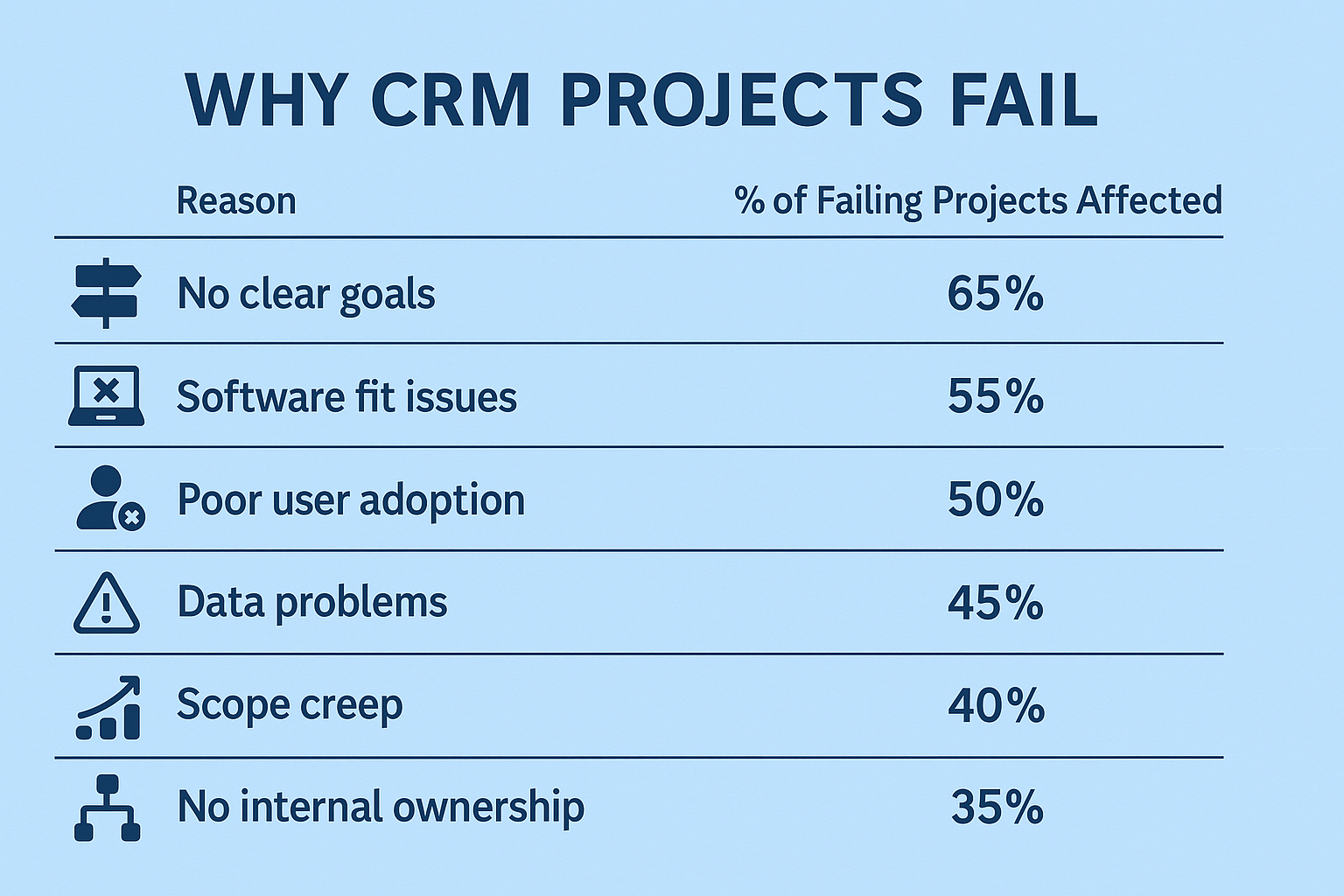Why Do So Many CRM Projects Fail? Lessons Learned (The Hard Way)

I've been building and fixing CRM systems for over a decade now.
And I can tell you — I've seen too many CRM projects that didn't deliver on their promises.
In fact, depending on which source you trust, anything from 30% to 60% of CRM projects either fail completely, or limp along without ever providing real value.
If you're reading this, there's a good chance you've seen one of those situations too.
The thing is — it's rarely the software itself that's to blame. Most of the time, CRM projects fail for reasons that have more to do with people, process, and planning than with technology.
Here's what I've learned about why CRM projects go wrong — and what you can do to give yours a much better chance of success.
Mistake #1: No Clear Purpose
One of the first questions I ask any new client is:
"Why are you doing this project?"
If they can't answer clearly, it's already a red flag.
Too many businesses launch into a CRM project because:
-
The old system is clunky
-
Management wants "better visibility"
-
A new manager likes Salesforce / Hubspot / XYZ platform
That's not enough.
If you don't know exactly what you're trying to improve — sales pipeline conversion? Speed of service? Renewal rates? — the project will drift. It becomes a tech exercise instead of a business one.
Mistake #2: Building the Wrong Thing
This happens all the time — companies choose a CRM platform first, and only later realise it doesn't actually fit their processes.
Result?
-
Endless configuration
-
Clunky workarounds
-
A system no one likes using
Software should fit your process — not the other way round.
Sometimes, off-the-shelf CRMs are fine. Other times, the smart move is to build something bespoke that matches how your business actually works.
Mistake #3: Forgetting About the People
CRM projects are often seen as "IT projects." They're not.
If your staff don't adopt the system, you won't get results — no matter how clever the technology is.
Poor adoption happens when:
-
The system is too complicated
-
It's seen as "extra work"
-
Users weren't involved in the design
-
Training was rushed
-
The project was led by IT, not business
You need strong leadership buy-in, clear communication, proper training, and user-centred design. Without those, you'll end up with a CRM no one wants to use.
Mistake #4: Data Chaos
CRM success depends on good data. But many projects start by migrating messy, duplicate, incomplete data from old systems.
If your users see errors and gaps, they won't trust the system — and adoption will crater.
I've seen so many projects sink because no one put enough time into data cleansing at the start.
Do the work. It's worth it.
Mistake #5: Trying To Do Everything at Once
A lot of CRM projects fail because they try to boil the ocean:
"We'll automate everything!"
"We'll add marketing automation, project management, chatbots..."
"We'll integrate with all 12 other platforms... in phase one."
Reality? It's too much. Staff get overwhelmed. Budgets explode. The whole thing slows down and dies.
Successful CRM projects start simple. They nail a few core workflows. Then expand gradually. Momentum matters more than features.
Mistake #6: No Internal Ownership
Here's a brutal truth: If your CRM is "owned" by IT or an external supplier, it will fail long-term.
Someone inside your business — usually from sales, marketing, or leadership — needs to own that system day to day.
CRM isn't a one-off project. It's a living part of how your business works. If no one owns it, it won't evolve — and it'll slowly fade into irrelevance.

How To Succeed
In short — you succeed when you:
✅ Know exactly what you’re trying to achieve
✅ Choose or build the right platform for your business
✅ Involve users from day one
✅ Clean your data
✅ Start small and scale
✅ Assign strong internal ownership
That’s what I’ve seen work again and again.
Final Thought
CRM can absolutely transform a business — if it’s done right. But if it’s done wrong, it’s a very expensive headache.
If you’d like to talk about what works (and what to avoid), we’re always happy to share what we’ve learned — no sales pitch, just an honest conversation.


